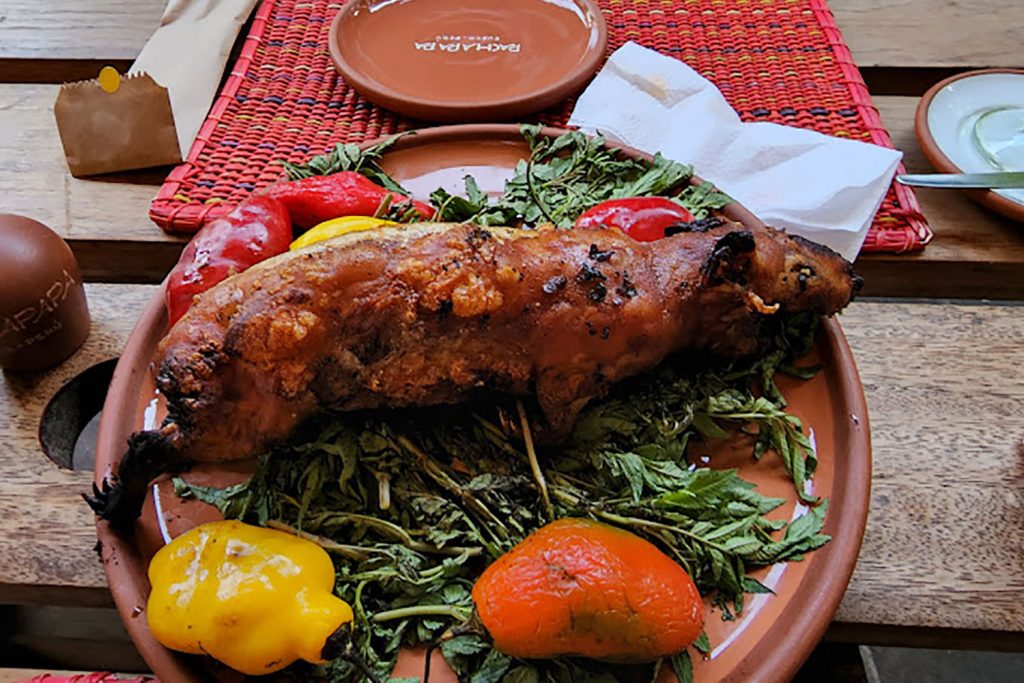The list was made by taking note of the dramatic advancements made by Peruvian cuisine within the country and abroad and then dives into its number one food.
1. CEVICHE, Peru’s national dish is more than just “RAW FISH”!!! Raw fish and seafood marinated in citrus juice, mainly lime and lemon juice.
The acid in the citrus juice denatures the proteins in the fish, causing it to become opaque and producing a firm texture. A more common way of denaturing proteins is by exposing them to heat (i.e. “cooking” them). So with ceviche, the fish is effectively “cooked” even though there’s no heat involved.
Ceviche recipes vary by region, and many different fish and shellfish can be used in preparing it Classic Ceviche typically includes onions, chilies and cilantro, sometimes sweet potato, it is served either chilled or at room temperature. Note that while heat is an effective method for killing the bacteria that cause food poisoning, marinating it in citrus juice is not. So it’s important to use the freshest seafood you could get, from a source you trust.
2. CAUSA LIMEÑA, a signature dish from Peru, Causa is the mashed and layered potato and seafood salad, can be layered with any number of fillings – chicken salad, tuna salad and avocado salad are favorites, there are endless ways to compose this dish and a big number of succulent sauces.
Causa captures three classic Peruvian ingredients – First – the Peruvian potato – Peru is famous for its thousands of varieties of potatoes and as a result there are many dishes that revolve around its endless varieties. The second essential component in Causa is seafood, this dish is easily adapted to include the best fresh seafood we can find. From fresh crab meat, to baby shrimp or prawns. The third – must-use ingredient is Aji Amarillo (Yellow Pepper). Google Causa Limeña for some inspiration and have fun making your own version of this classic Peruvian specialty.


3. ROCOTO RELLENO, is the Peruvian variety of “Stuffed Peppers”, a dish popular in the city of Arequipa “The White City”, famous for its take on dishes derived originally from Spain. Since the sweet peppers used in Spain were not available in Peru, Rocoto peppers were substituted, which were cooked in water and vinegar to remove as much spiciness as possible.
Hard-boiled eggs are placed inside the Rocotos and is then topped with melted cheese, baked and served whole. Rocotos are at least ten times spicier than jalapeño when raw. Cooks have some secrets to tame the heat of Rocotos and make them edible for everyone. The dish is served mildly spicy and the stuffing inside the Rocoto can include anything. The most popular stuffing is a beef-mix which contains beef, vegetables, onions, garlics, margarine (butter) cream and pecans.
4. AJI DE GALLINA, or the “Spicy Creamed Chicken”, slightly spicy and bright yellow from the famous aji Amarillo or yellow peppers (they often look more orange than yellow), and rich from the unusual cream sauce made with ground walnuts. This dish is traditionally served over rice, with boiled yellow potatoes and black olives.


5. GUINEA PIG, called “CUY” is a Peruvian delicacy from the Andes region. It would be a sin to leave Cusco without trying it. This cute and tiny animal is highly regarded among Peru, Bolivia and Ecuador’s indigenous cultures and is used in several ways, but primarily as a food source.
Here, Cuy serves as a good source of low-on-the-food-chain animal protein for people living in the hilly regions. It is also used in spiritual practices and healing ceremonies, performed on the patient by a healer “Inca Paqo”. The Cuyes are roasted to a crisp; they are cut into pieces for everyone to eat. The meal is accompanied with Rocoto relleno “Stuffed Chili Peppers” and roasted potatoes The cuy has a crunchy texture, and also has a greasy chicken-like flavor.
The Cuy is best eaten with the hands as the meaty portions are easier to get at, so forks and knives are practically useless. This is part of the traditional cuisine of the Andes, a dish served by indigenous people from Ecuador, Peru and Bolivia. After eating this dish you will never see Guinea pigs in the same way again.
6. LOMO SALTADO is one of the most popular Peruvian dishes and symbolizes like no other the fusion of Peruvian ingredients with Asian techniques of preparing food. This meal is made of sliced beef stir-fried with red onions, tomatoes, yellow Peruvian chilies (aji amarillo), soy sauce, vinegar and cilantro. Mixed with French fries and served with rice Lomo Saltado can be found in simple restaurants and up-scale places alike.


7. ANTICUCHOS DE CORAZON or “Beef heart skewer” In Peru, the country of origin of Anticuchos de Corazón, they are prepared from chunks of beef heart marinated for several hours, which are then skewered and grilled. It was one of the most important dishes served to the slaves of the old Viceroyalty of Peru. Today, several versions of this dish are served in Peru, Bolivia, Argentina and Chile.
In Peru, Anticuchos are found at every street corner and there is no BBQ without Anticuchos in the country! At the time of the Incas, Anticuchos were prepared with llama or Alpaca meat cut into pieces, flavored fresh herbs and pepper. Years later, with the arrival of the Spanish, beef replaced llama and Alpaca, and garlic became a key ingredient in the recipe. The contempt of the Spanish from Lima for offal and less noble animal parts made them serve these meats to black slaves.
They cut the beef heart into pieces and marinated them in vinegar and chicha “Incan beer”, an Andean beverage made from corn. This drink is particularly found in Ecuador, Peru, Bolivia, Venezuela, and Colombia. After a long marinade, they used to grill or fry them; later, thin sugar cane stalks were used as skewers. Although Anticuchos can be prepared with all types of meat, in Peru, the most popular ones are made with beef heart and usually served with potatoes.
8. GRILLED ALPACA, It is nice and rare inside with a wonderful grilled taste on the outside; it is usually served with fresh vegetables and French fries. In the Andes of Peru Alpaca meat is an important food source. Alpaca has a lot of protein and it is also low in fat and cholesterol. Alpaca meat also has essential minerals to the human diet and can be compared with beef.


9. POLLO A LA BRASA, also known as “Peruvian Chicken” or “Rotisserie chicken” in the United States and “Charcoal Chicken” in Australia is a common dish of Peruvian cuisine and one of the most consumed in the country; the crispy skin that covers the soft and juicy meat is a marvel that fuses with the best of fried Andean yellow potatoes.
The history of this delicious food goes back to 1950 and the hacienda of Mr. Roger Schuler, of Swiss Origin, whose original business was a chicken farm near Lima, the Peru’s capital. With its earnings he hoped to support his family but the farm started going bust. On seeing that if he could not sell the chickens fast enough they would die and he would lose a large amount of money, he had a great idea to try and sell the young chickens.
For this he and the cook in his house created a recipe of marinating the chickens in salt water based marinade and then cooking them over a slow fire on Carob tree coals. An hour of cooking would give them the famous result of Pollo a la Brasa or Chicken over coals.
Originally its consumption was specific to the wealthy people (during the 1950s until the 1970s), but today it is widely available and a typical plate of 1/4 chicken with fries and a salad can be bought for about 15 soles, or just under $5. The original version of the Pollo a la Brasa consists of a chicken (cooked in charcoal and marinated only with salt) served with large french fries and traditionally eaten with the fingers, without cutlery, although most modern Peruvians will eat it with a fork and knife. It is almost always served with creamy (mustard and mayonnaise-based) sauces, especially spicy chili cream sauce called ají.
10. CHICHARRON DE CERDO, in Perú is made using what is called “Country style pork rib” in the US. The rind is not used at all. The meat is boiled with seasonings and spices till no water remains, and then fried in its own fat. It is often served as a brunch food on a baguette with chopped red onions and mint leaves for good digestion. Sides include corn; fried potato and other regional variants. Chicharrón can also be prepared with fish and chicken.













